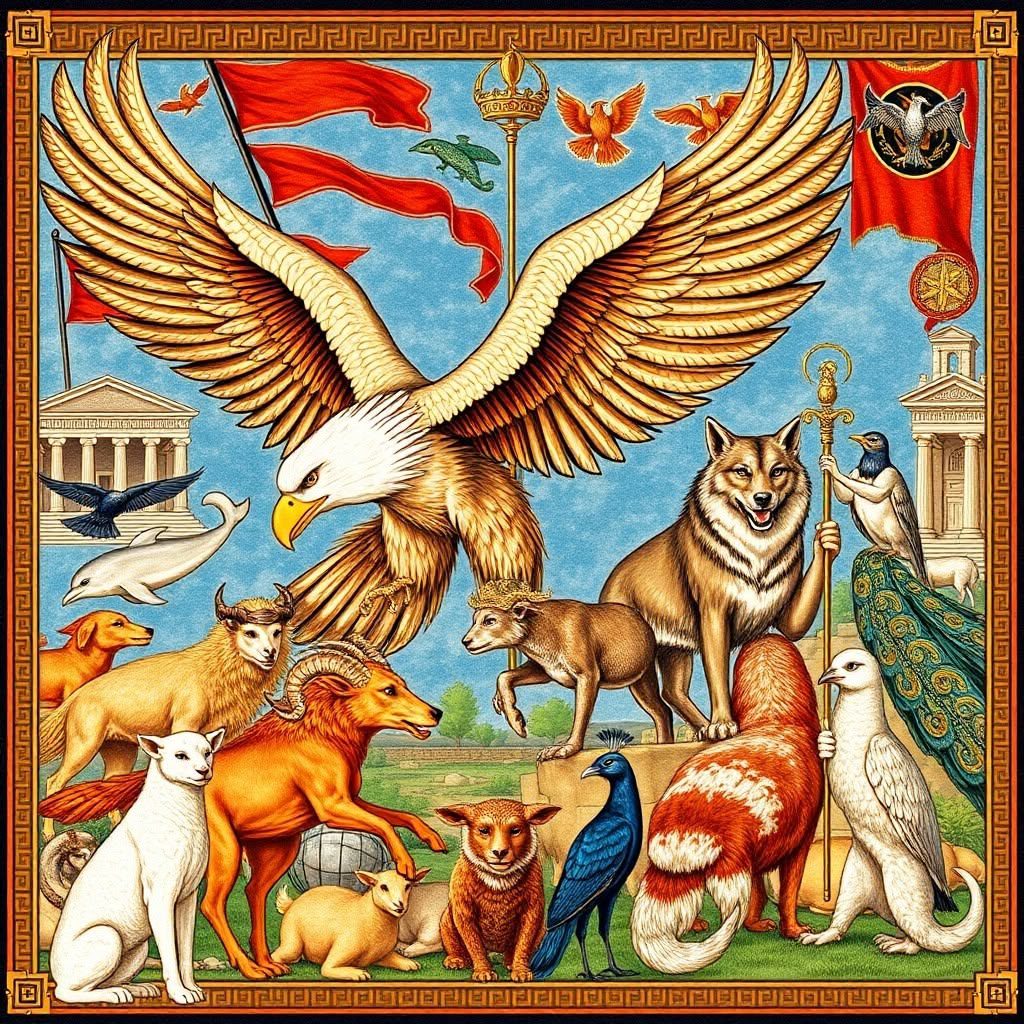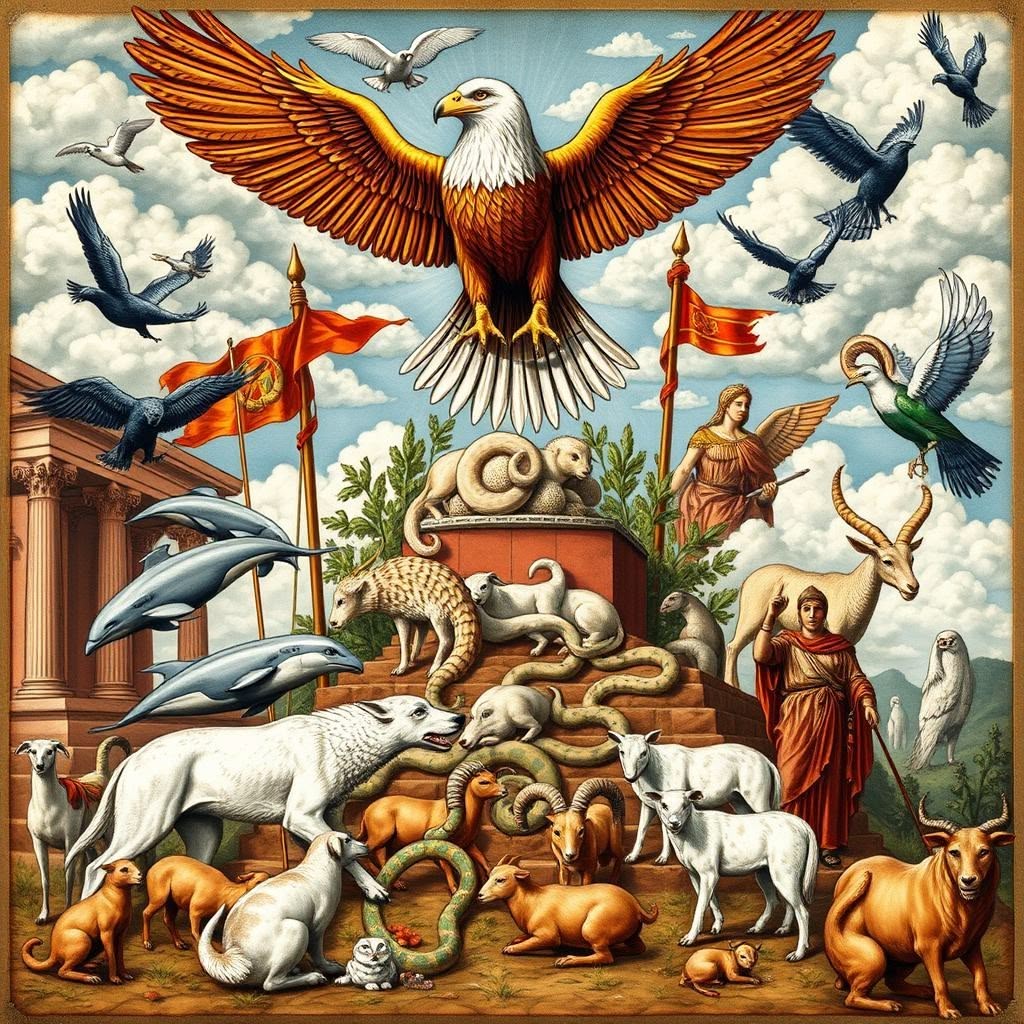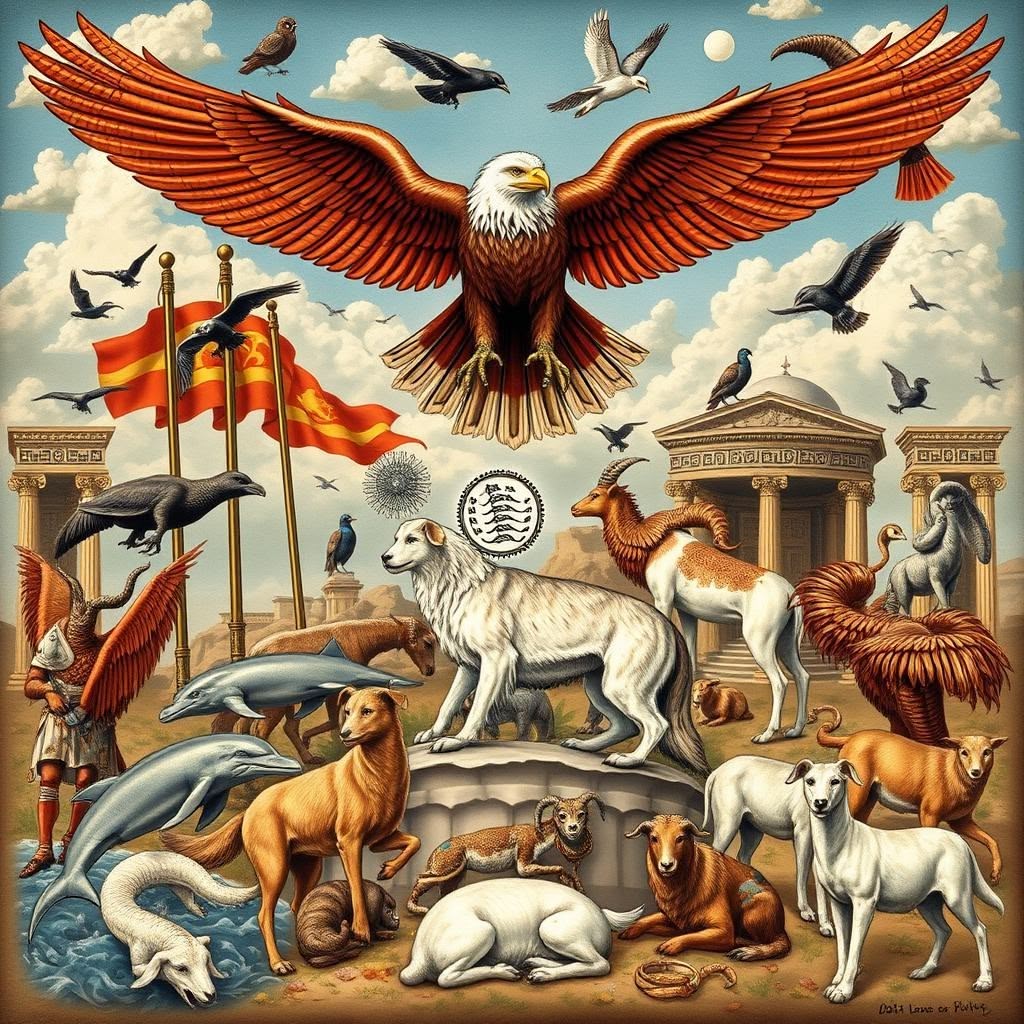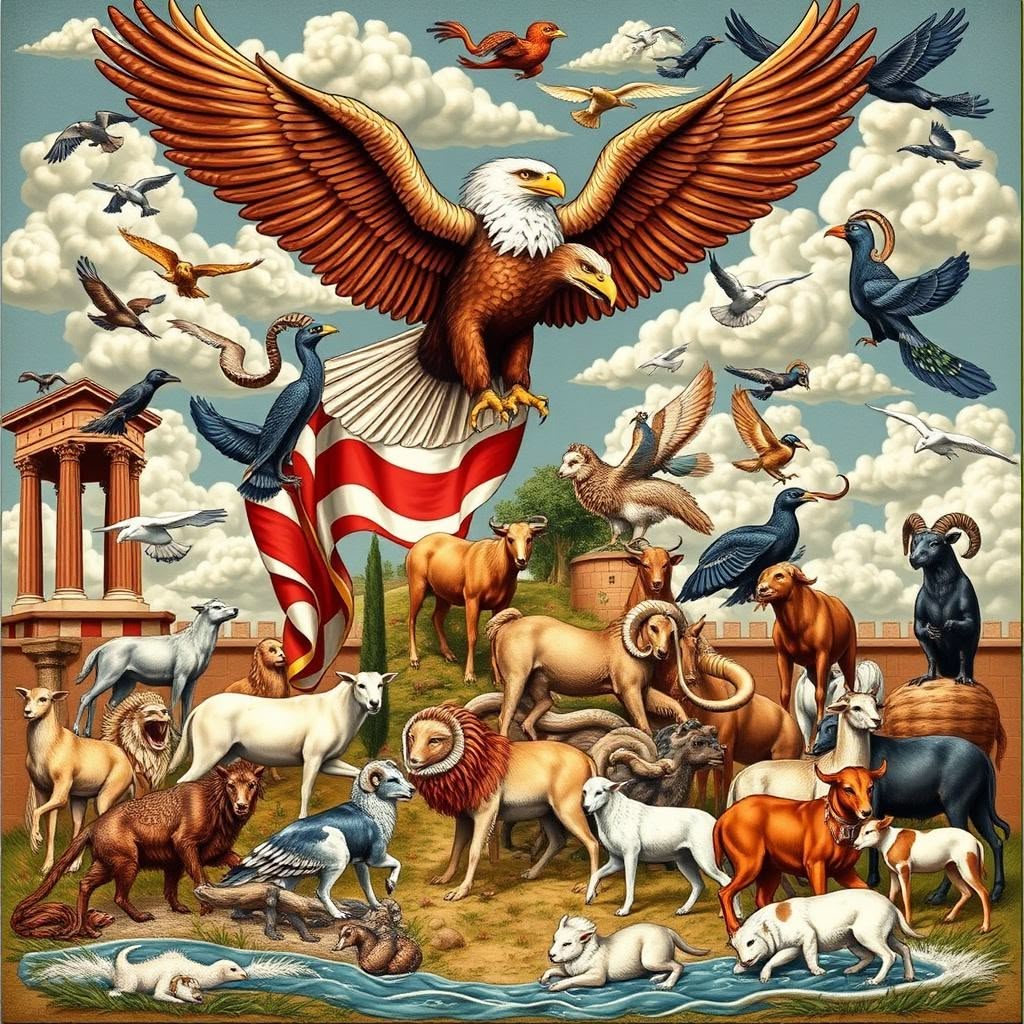Animal symbolism in Roman art and religion—From Eagles to Wolves—offers a vivid window into the values, beliefs, and daily realities of ancient Rome. Animals were not merely decorative motifs; they embodied complex meanings that connected the mortal world with the divine. Roman artists and religious practitioners used animal imagery to express ideas about power, protection, fertility, healing, loyalty, and cosmic order.
This multifaceted role reflects how deeply intertwined animals were with Roman identity. Understanding their symbolism enhances our appreciation of Roman art’s rich iconography and reveals how religion permeated all levels of society. The following exploration uncovers notable examples—from imperial eagles soaring over battle standards to the nurturing she-wolf of Rome’s foundation myth—that illustrate animal symbolism’s significance in shaping ancient Rome’s cultural landscape.
Moreover, the influence of animal symbolism extended beyond art and religion into the realm of law and social structure. For instance, the legal status of women in ancient Rome was significantly shaped by their relationships with men, such as fathers or husbands. This complex interplay of rights and restrictions is a fascinating aspect of the legal status of Roman women.
Additionally, the philosophical underpinnings of Roman thought were heavily influenced by Greek philosophy. The rise of Stoicism in Rome emphasized living in harmony with nature and using reason—principles that resonate with the virtues often embodied by animals in Roman symbolism. This illustrates how deeply ingrained these beliefs were in shaping Roman thought.
In summary, animal symbolism serves as a multifaceted lens through which we can understand the intricate weave of art, religion, law, and philosophy that defined ancient Rome.

The Role of Animals in Roman Religion and Art
Roman religion intertwined closely with the symbolism of animals, incorporating them into both religious practices and artistic representations. These creatures held a dual significance, serving symbolic and practical functions within the realms of religion and art. The connection between mythology, rituals, and visual arts further enriched the cultural tapestry of ancient Rome.
1. Integration into Religious Practices
Animals played a pivotal role in Roman religious ceremonies, symbolizing various virtues, gods, and cosmic entities. They were often used as sacrificial offerings to appease deities or seek divine favor. The choice of animal for sacrifice carried specific symbolic meanings tied to the desired outcome of the ritual.
2. Artistic Representations
In art, animals were depicted not only as symbols but also as embodiments of divine qualities or mythological narratives. Sculptures, paintings, and mosaics showcased intricate details of animals to convey specific messages or stories from Roman mythology. These artistic representations served to reinforce the importance of animals in religious beliefs and societal values.
3. Symbolic and Practical Functions
Animals in Roman culture served a dual purpose by embodying symbolic meanings while also fulfilling practical needs. Whether as guardians of temples, companions in daily life, or participants in religious rites, animals held a significant place in both spiritual and mundane aspects of Roman society.
4. Mythology to Visual Arts Connection
The legends and myths surrounding animals in Roman mythology often found expression in visual arts. Artists drew inspiration from these tales to create stunning portrayals of mythical creatures or sacred beasts. This fusion of storytelling through art allowed for a deeper understanding of the cultural significance attached to different animal symbols.
Through the seamless integration of animals into religious practices and artistic expressions, Romans conveyed their beliefs, values, and connections to the divine world with intricate detail and profound symbolism. This cultural richness was often reflected in the lifestyle of the wealthy elite known as the patricians, who wielded significant power and influence in ancient Rome.

Iconic Animal Symbols in Roman Culture
The animal symbols in Roman culture were deeply intertwined with their mythology, military, and societal structure.
Eagles as Emblems of Jupiter and Imperial Power
The eagle, a powerful symbol in Roman culture, represented Jupiter’s divine authority. It was not just a representation of the sky god but also an emblem of imperial power. This symbolism was especially pronounced in military contexts, where the eagle was prominently used on standards and in public art. The Roman army, a symbol of military power, played a crucial role in establishing and maintaining this imperial power.
Wolves: Founding Myths and Martial Strength
On the other hand, wolves held a significant place in Rome’s founding myths. The iconic Capitoline Wolf statue, which depicts the nurturing of Rome’s founders Romulus and Remus by a she-wolf, is a testament to this symbolism. Wolves were sacred to Mars, the god of war, embodying qualities such as strength, loyalty, power, and at times cruelty in Roman literature. These attributes were not only associated with the wolf but also reflected in the character of significant historical figures such as Scipio Africanus, known for his crucial role in the Second Punic War.
Both eagles and wolves served as powerful symbols within Roman culture. The eagle signified imperial power and military might while the wolf represented strength, loyalty and played a pivotal role in Rome’s foundational myths.

Dolphins, Snakes, Dogs, Goats, Sheep, Rams: Diverse Animal Symbolism in Roman Art and Religion
Dolphins: Divine Helpers of Apollo
In Roman culture, dolphins were associated with Apollo, the god of light, music, and healing. These swift creatures were seen as divine helpers who assisted fishermen at sea. Their positive symbolism extended to representing divine favor and protection. In both art and mythology, dolphins symbolized grace, agility, and assistance from the gods.
Snakes: Symbols of Health and Rejuvenation
Snakes held great significance in Roman symbolism through their connection with Asclepius, the mythical healer. Representing health and medical knowledge, snakes were often depicted in sculptures and paintings within religious contexts. Their presence conveyed ideas of rejuvenation, transformation, and the cycle of life and death.
Dogs: Loyal Companions in Mythology
Depictions of dogs in Roman art showcased them as loyal companions and protectors. They played essential roles in mythology as hunting or guard dogs symbolizing fidelity and vigilance. Dogs were revered for their unwavering loyalty to their masters and were often portrayed alongside deities or heroes as symbols of devotion.
Goats, Sheep, Rams: Symbols of Rural Life
The connection between rural life and pastoral deities like Faunus brought goats, sheep, and rams into the realm of Roman symbolism. These animals represented various aspects such as fertility, sexuality, piety, and devotion to nature gods. Their presence in art conveyed themes of abundance, vitality, and the cyclical nature of life within agricultural communities.
The Rich Tapestry of Animal Symbolism
Each of these animals—dolphins aiding fishermen, snakes symbolizing healing, dogs embodying loyalty, and goats/sheep/rams representing rural life—contributed to the diverse animal symbolism found in Roman art and religion.
Through their portrayal in sculptures, mosaics, frescoes, and literature as detailed in this journey through ancient Roman art, these creatures added layers of meaning to the visual landscape of ancient Rome.

Birds Beyond the Eagle: Varied Symbolism in Roman Beliefs
Birds played a significant role in Roman beliefs, representing various symbolic meanings beyond the eagle. Here are some key points to consider:
1. Ravens as Weather Messengers
In Roman culture, ravens were revered for their ability to predict weather changes and divine signs. They were seen as messengers carrying important omens, particularly related to natural phenomena and celestial events.
2. Owls Representing Wisdom and Death
Owls held a dual symbolism in Roman beliefs, embodying both wisdom and foreboding associations with death or misfortune. While they were admired for their perceived wisdom, they were also considered omens of impending doom or ill-fortune in certain contexts.
3. Peacocks Associated with Juno and Fertility
Peacocks were sacred birds closely linked to Juno, the goddess of marriage and fertility. They symbolized beauty, regality, and abundance, representing divine favor and prosperity. In Roman art and religion, peacocks were often depicted as emblems of fertility and rebirth.
These bird symbols added depth to Roman artistic expressions and religious practices, enriching the cultural tapestry with their diverse meanings and associations. Such rich symbolism is just one aspect of the broader influence of Roman mythology on modern culture. Additionally, these beliefs are part of a larger context that includes animals in ancient Greece and Rome, which played significant roles in their respective cultures.
Moreover, understanding these symbols can provide insights into the intricate societal structure of ancient Rome, which was further defined by remarkable engineering feats such as the construction of Roman roads that connected far-flung regions ensuring effective governance and cultural exchange.
Additionally, exploring other facets of Roman society such as the life of gladiators who were heroes or victims of Roman entertainment, or understanding the historical transition from monarchy to a republican system during the birth of the Roman Republic, can provide a more comprehensive view of this fascinating civilization.

Practical Roles of Animals in Roman Life and Rituals
Animals had various important roles in the daily lives and religious ceremonies of Romans. They added both practical benefits and symbolic meanings to the culture. Here are some key points to consider:
1. Animals in Religious Sacrifices and Purification Rituals
- The Suovetaurilia sacrifice was a crucial ritual involving a pig, sheep, and bull for purification purposes.
- During marriage ceremonies like confarreatio, sheep or lambs were sacrificed symbolizing purity and fertility.
2. Fortune-Telling through Augury Based on Birds’ Flight Patterns
- Augury was a common practice where priests interpreted bird behavior to make decisions.
- Specific birds’ flights held spiritual significance guiding the course of events.
3. Entertainment Involving Exotic Animals
- Exotic animals, like lions imported by Julius Caesar, were used for public games providing entertainment but also serving as symbols of power. These spectacles are reminiscent of the grand entertainment events in Ancient Rome, which included gladiatorial games and chariot races.
- Animal fights were not only a form of amusement but also served as punishments for criminals.
4. Horses in Public Events like Circus Maximus Races
- Horses played a pivotal role in chariot races at Circus Maximus, symbolizing speed, competition, and grace.
- These events were not just about entertainment but also showcased the prowess and status of charioteers.
5. Pets in Roman Society
- Domestic pets such as dogs and birds were cherished companions in everyday Roman life.
- Beyond their symbolic roles in art and religion, these animals provided comfort, security, and joy to their owners.
The practical use of animals in various aspects of Roman society shows that they were important for more than just symbolism. They played vital roles in religious ceremonies, cultural practices, entertainment events, and personal relationships. This diverse interaction with animals highlights the close connection between nature and civilization in ancient Rome.

Conclusion
The rich symbolism of animals in Roman art and religion reveals the cultural values and beliefs of ancient Rome. This exploration is part of a larger journey into the fascinating world of Ancient Rome, from its beginnings as a Republic to its rise as a powerful Empire.
These symbolic representations continue to resonate throughout history, providing insight into the complex nature of Roman society. The legacy of Ancient Rome remains a cornerstone of Western civilization, influencing various aspects of modern society.
Through the study of animal symbolism—from eagles to wolves—we uncover the deeper meanings behind every artistic depiction and religious practice. Each animal represents not only a physical presence but also virtues, gods, and practical elements of life in Roman culture.
As we explore the connections between animals and Roman civilization, we discover stories that reveal power dynamics, protection, fertility, loyalty, and divine favor. These narratives are closely linked to daily life in ancient Rome, where different social classes experienced vastly different ways of living.
By examining animal symbolism in Roman art and religion—from the imperial eagle to the sacred wolf—we uncover a wealth of cultural heritage that continues to captivate and inspire us today. This cultural heritage is part of an extensive journey through time that has left an indelible mark on the world. Additionally, understanding Roman law is essential for grasping the foundations of contemporary laws as its principles are still relevant in various legal systems today.
FAQs (Frequently Asked Questions)
What roles did animals play in Roman art and religion?
Animals in Roman art and religion served multifaceted roles, symbolizing gods, virtues, and practical aspects of life. They were integral to religious rituals, mythological narratives, and artistic representations, embodying both symbolic meanings and everyday functions within ancient Roman culture.
How were eagles and wolves symbolically significant in ancient Rome?
Eagles symbolized Jupiter’s divine authority and imperial power, especially in military contexts, often featured in standards and public art. Wolves held sacred significance linked to the founding myth of Romulus and Remus, associated with Mars the god of war, representing strength, loyalty, power, and sometimes cruelty in Roman literature.
What diverse animal symbols appear in Roman art beyond eagles and wolves?
Roman art features dolphins as divine helpers linked to Apollo, snakes symbolizing health through Asclepius the healer god, dogs representing loyalty and protection, and pastoral animals like goats, sheep, and rams connected to fertility, sexuality, and piety under rural deities such as Faunus.
How did birds other than eagles contribute to Roman symbolic beliefs?
Birds like ravens served as weather messengers predicting divine signs; owls represented wisdom but also omens of death or misfortune; peacocks were sacred to Juno symbolizing fertility and divine beauty. These varied bird symbols enriched the religious and cultural tapestry of ancient Rome.
What practical roles did animals have in Roman rituals and daily life?
Animals played key roles in religious sacrifices such as the Suovetaurilia (pig, sheep & bull) for purification rituals; sheep or lamb sacrifices symbolized purity during marriage ceremonies like confarreatio. Animals were also central to augury through bird flight patterns for fortune-telling; exotic animal displays provided entertainment; horses were vital for chariot races at Circus Maximus; while dogs and birds served as beloved pets.
Why is understanding animal symbolism important for studying ancient Rome?
Animal symbolism offers profound insights into ancient Rome’s culture by revealing how Romans understood divinity, virtues, social values, and everyday life. Through art and religion, animals reflect the interconnectedness of mythology, ritual practice, imperial power, and societal norms—providing a lasting legacy that enriches our comprehension of Roman civilization.

